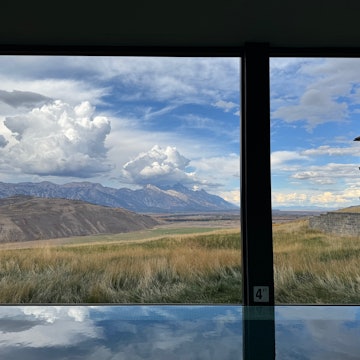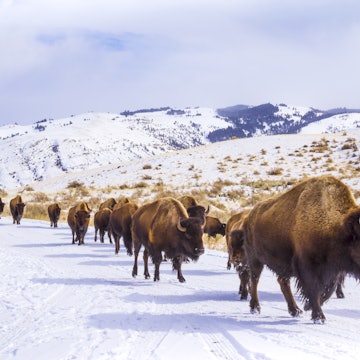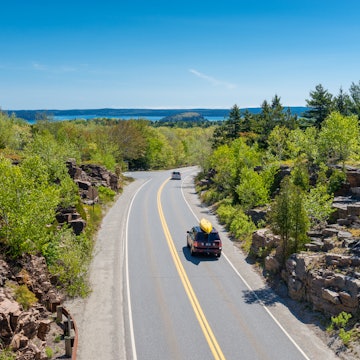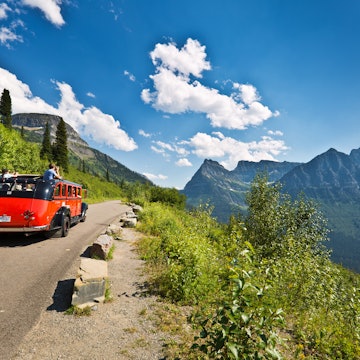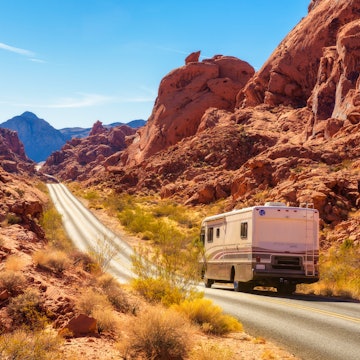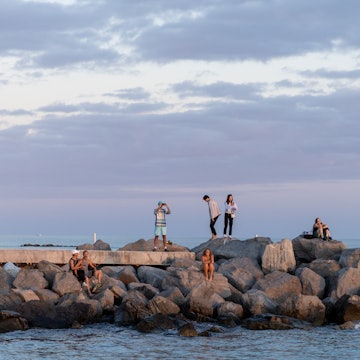
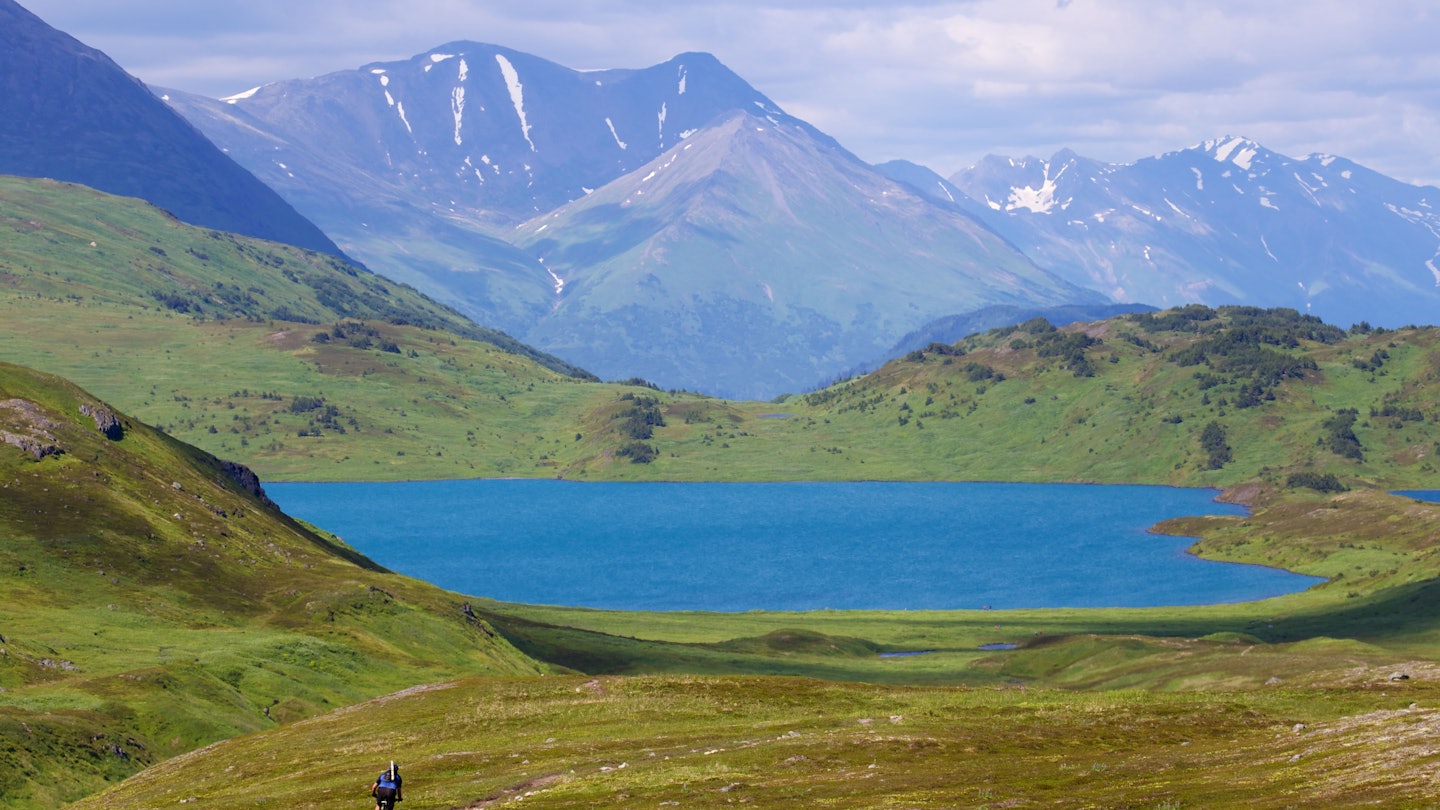
The Kenai Peninsula brings all your Alaskan adventures within reach © CSNafzger / Shutterstock
From Alabama’s rock-and-soul capital to Wyoming’s stunning parkland, from the oldest city in the US to the jaw-droppingly beautiful beaches of the States' northern “third coast,” we’ve gathered budget destinations in each state, plus Puerto Rico.

Our mission is simple: track down outstanding destinations in all 50 states and Puerto Rico where lodging averages well under $200/night and great food and drink, natural beauty, and vibrant arts and culture share the spotlight. No pressure, right? Here’s to kicking off the new decade with an unparalleled to-do list!
Alabama: Muscle Shoals
It’s time for Muscle Shoals, Alabama, to take its rightful place alongside America’s major pop music destinations like Memphis, Cleveland, and Detroit. Here, in this small town in the northwestern corner of the state, some of the most popular and critically acclaimed rock and soul music – including seminal works by Aretha Franklin, the Rolling Stones, and Lynyrd Skynyrd – was recorded at Fame Studios and Muscle Shoals Sound Studios.
These days, you can enjoy a music-themed visit to the area while also savoring its first-rate comfort food and natural beauty. Tour the Alabama Music Hall of Fame, in Tuscumbia; make a pilgrimage to Muscle Shoals Sound Studios, in Sheffield; and drop by Pegasus Records, in Florence, for its Friday-night showcases of emerging musical talent. Alabama Shakes were discovered at Pegasus – who will you discover?

Alaska: Kenai Peninsula
Alaska isn’t quite as far away as you think: an authentic Alaska experience, complete with whale watching, hiking, fishing, and ogling wildlife, is available in the Kenai Peninsula, along the state’s southern coast, south of Anchorage.
Whether you approach this vacation wonderland via cruise ship or a road trip on the Seward Highway (one of America’s finest scenic drives), you’ll find enough activities to last a week or a month, including a boat tour of Kenai Fjords National Park; hiking in Chugach National Forest, and viewing animals you won’t easily find in the lower 48, including orcas and puffins. And an irresistible perk of visiting this corner of Alaska is that you’ll taste the freshest, most deeply flavorful salmon anywhere in the world.
Arizona: Saguaro National Park
Some travelers keep a list of rare or unique sights they must see. The saguaro cactus is something every American should visit in person. Saguaro National Park, Arizona, near the always rewarding city of Tucson, is devoted to protecting and preserving a forestful of the immense succulents, which are unique to the Sonoran Desert and can grow to a height of 50 feet and live more than 200 years.
In addition to these “kings of the Sonoran Desert,” you’ll also find towering pine-covered mountains alive with wild javelina, coyotes, desert tortoises, and, at higher elevations, black bear and the Mexican spotted owl.

Arkansas: Ozark-St. Francis National Forests
Not one but two major national forests crossed by six US Scenic Byways? Yes, Arkansas delivers thousands of acres of four-season activities in the Ozark-St. Francis National Forests, in the state’s northern and eastern regions. Here, from the shores of the Mississippi River to the deep woods filled with wildlife and opportunities for water sports, visitors discover an unexpected side of Arkansas.
Choose between cycling and canoeing, fishing for striped and largemouth bass and catfish, swimming in Bear Creek Lake, camping amid the hardwood trees, and hopping an ATV – or, our recommendation, try them all.
California: San Pedro
Think you know California? Meet San Pedro, at the southern point of the Palos Verdes Peninsula and home to the Port of Los Angeles, the largest in the US. Here in this up-and-coming must-see city, you’ll delight in packing your days with an array of pursuits: ride the free San Pedro Downtown Trolley with hop-on-hop-off stops at the incredible collection of nautical vessels at the Los Angeles Maritime Museum, beautiful Cabrillo Beach, and the jaw-dropping Cabrilla Marine Aquarium, designed by Frank Gehry.
History buffs and kids of all ages will want to visit the Battleship Iowa Museum, the only battleship open to the public on the West Coast, and everyone will appreciate a meal at California’s biggest seafood restaurant, the San Pedro Fish Market & Restaurant – get ready to snap a few they-won’t-believe-this-back-home pics of the immense shrimp trays.

Colorado: Black Canyon of the Gunnison National Park
Southwest Colorado is home to a lesser-known gem: Black Canyon of the Gunnison National Park. Located near the city of Montrose, the site is an incredible natural landscape featuring black cliffs (formed 2 billion years ago) towering 2,000 feet above the Gunnison River.
Stock up on food and water in Montrose, then head for the canyon’s South Rim, where you’ll find gentle nature trails with Instagram-ready overlooks, backcountry experiences for visitors who yearn to get off the beaten path, and an array of opportunities for camping, fishing, and rock climbing. Consider participating in ranger-led programs to learn about the geology and wildlife of the area.
Connecticut: Mystic Seaport
For travelers in the Northeast, America’s most important collection of National Historic Landmark maritime vessels is just off I-95 in northern Connecticut. Mystic Seaport’s towering sailing ships will delight children, of course, and grownups (especially fans of the novels of Patrick O’Brien and Herman Melville) who want to step back in time to the days of wooden ships.
Tour a whaleship, an active waterfront, planetarium, gardens, and hands-on experiences that help you appreciate the crafts that went into the construction and maintenance of these amazing vessels. Art lovers will savor the excellent Maritime Gallery, which hosts major exhibitions of marine art and intricately detailed miniature ship models.
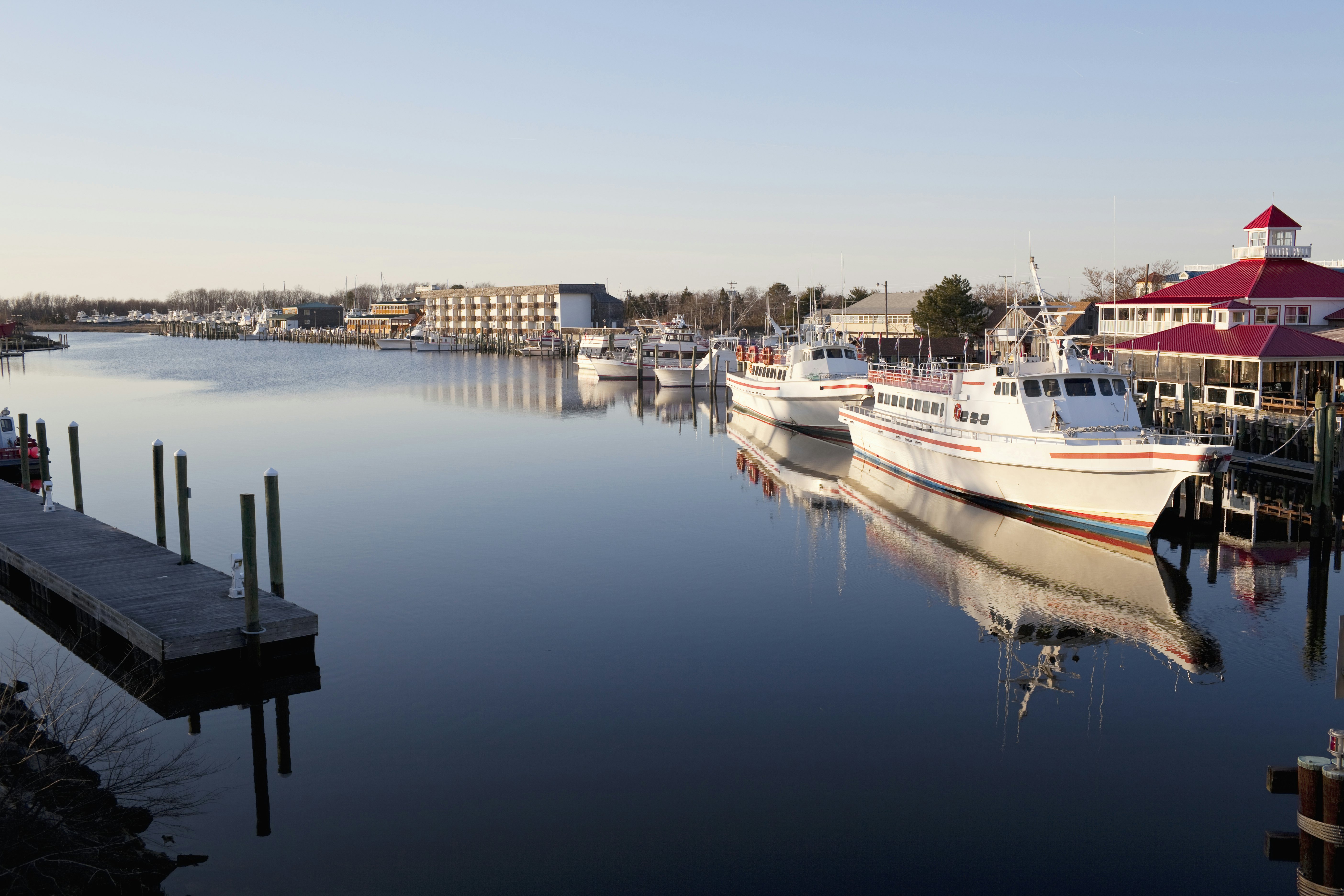
Delaware: Lewes
We believe too many travelers simply pass through compact Delaware on their way somewhere else. It’s time to slow down and enjoy this welcoming mid-Atlantic state, and the charming town of Lewes, where the Atlantic Ocean meets Delaware Bay, is the perfect place to do so.
The vibrant downtown is perfect for strolling and popping into unique boutiques and seafood restaurants, and the lovely beaches just minutes away. Have your camera or smartphone ready for iconic shots of Breakwater Lighthouse, cycle or walk the Lewes Canalfront, and devote some time to exploring Cape Henlopen State Park with its scenic trails, beaches, campgrounds, and pier.
Florida: St Augustine
If “founded in 1565” sounds unusually old for an American city, well, it sure is. St Augustine is commonly referred to as the oldest city in the US (in actuality, it is the longest continually inhabited European-founded city in the nation). Here, visitors find an experience that is decidedly different from – and a wonderful complement to – Florida’s beaches and theme parks.
Immerse yourself in 400 years of history that includes an array of cultures, including Native American, Spanish, British, African American, and Greek. Must-see sights include the Castillo de San Marcos (this is the classic I’m-in-St.-Augustine image), the narrow European-style streets, an array of museums dedicated to local history and cultures, and even Spanish explorer Ponce de Leon’s legendary “Fountain of Youth.”
Georgia: Alpharetta
From the coast to bustling Atlanta to the mountains, Georgia offers well-known vacation charms. We want travelers to add the city of Alpharetta, in the Atlanta metro area, to that list. If you’re looking for a welcoming community with endless eating options (more than 200 restaurants), an exceptional craft brewery experience at Jekyll Brewing, and ample parkland (750 acres), including the eight-mile-long Big Creek Greenway, Alpharetta, an easy drive from downtown Atlanta, makes a great day trip or weekend escape.
If all that sounds as if it ought to be topped off with an evening of fine music, head to The Velvet Note, honored by Downbeat Magazine as one of the world’s best jazz venues.
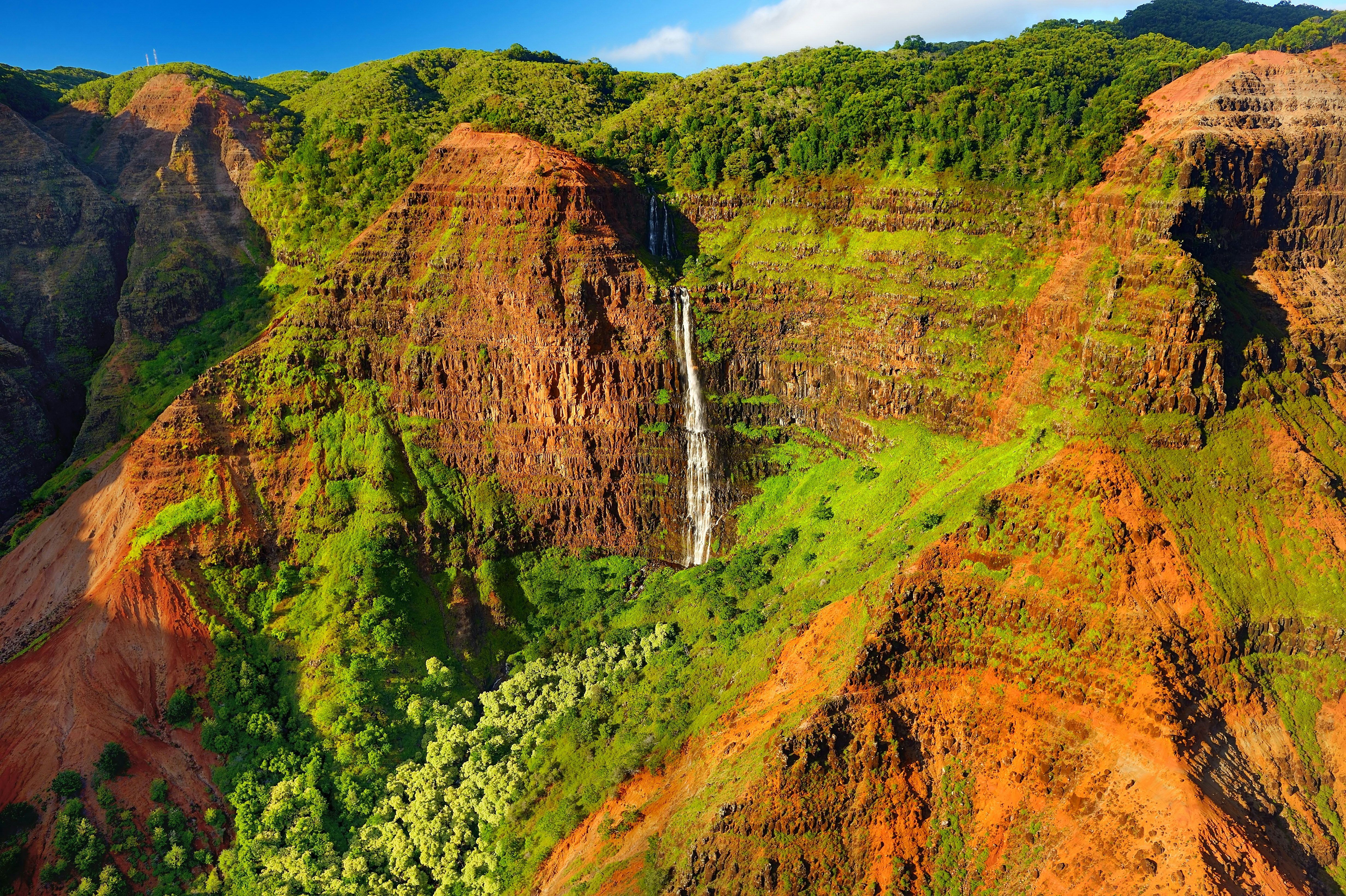
Hawaii: Waimea Canyon State Park
Have you seen the “Grand Canyon of the Pacific”? On the western side of the Hawaiian island of Kaua‘i, Waimea Canyon is 14 miles long, more than 3,600 deep, and boasts an array of colorful, gorges, and buttes that do, indeed, remind many visitors of Arizona’s famous canyon.
And, of course, this being Hawaii, the gorgeous surroundings go beyond the canyon: Waimea Valley is home to a 45-foot waterfall and thousands of beautiful botanicals along an easy paved path. For an elegant splurge, there are 60 vintage restored cottages along the beachfront just south of the park.
Idaho: Snake River Valley
Another canyon that most travelers have not yet discovered awaits in Idaho, where the Snake River winds through prehistoric lava flows to create a 50-mile canyon where you’ll find photo-ready waterfalls and springs. Stroll along the 10-mile paved walking path on the south rim with access to a visitor center.
Then head to the iconic Perrine Bridge, where you can stand nearly 500 feet above the river and recall the exploits of 1970s daredevil Evel Knievel, who attempted to jump the canyon here (unsuccessfully, alas). You may also see BASE jumpers taking the plunge off the bridge. Just south of the bridge, you’ll find scenic overlooks of the canyon and at the beautiful Shoshone Falls; beautiful; Centennial Waterfront Park is just west of the bridge.

Illinois: Route 66 Heritage Project
Sure, you know kitschy Route 66, and may have driven a stretch or two of the “Mother Road.” But exploring the 300-mile Illinois portion of the quintessential US highway may be the kitschiest stretch of all. Snap some pics at the beginning of your journey, in downtown Chicago at the “Route 66 Begin” sign on E. Jackson Boulevard.
Once you’re on the road, there are many tempting places to stop: Dell Rhea’s Chicken Basket has been famous or its fried chicken since the 1940s; the Illinois Route 66 Hall of Fame and Museum is a treasure trove of vintage artifacts; the 19-foot-high Paul Bunyan clutching an immense hot dog across the street from The Palms Grill Cafe announces its presence from a distance and delights passersby; the world’s largest covered wagon awaits not far down the road, alongside a statue of Abraham Lincoln. The road rolls on, and the kitsch rolls along with it, all the way to the Chain of Rocks Bridge across the Mississippi and into St Louis, Missouri.
Indiana: Nashville
Did you know there was “another” Nashville? And that it’s also a significant music destination? Here in southern Indiana, Nashville was an artists’ colony in the early 20th century, establishing a tradition of creativity complete with galleries and crafts studios.
These days, the community has become a mecca for musicians, with a great schedule of performances at the Brown County Playhouse and shops like Weed Patch Music Company with its stash of custom guitars and banjos. Music pours forth from cafes and wine bars, and, of course, on the streets.

Iowa: Sioux City
This little city in northwest Iowa has earned big honors for its livability, cuisine, and economic development. For travelers, that all translates into an experience that combines small-town warmth with big-city style and culture. Families will especially love the LaunchPAD Children’s Museum and the Lewis & Clark Interpretive Center. Culture vultures must see the Art Center and hear the Sioux City Symphony Orchestra.
Outdoor fun is a four-season priority here, as the city continues to develop trail connectivity and riverfront development, and a wide diversity of multicultural cuisine sets Sioux City apart from most small cities in the heartland.
Kansas: Colby
Start at the Prairie Museum of Art and History to get a sense of Colby’s place in the settlement of the prairie and its vibrant artistic legacy; while you’re at the museum, don’t miss its Cooper Barn, the largest barn in the state.
Colby’s new 2.2-mile walking trail is a good way to get a sense of this special town, with its especially noteworthy historic courthouse. The best times to get to know Colby may be during its annual festivals: in April, you can take a taste of the Great Oasis Cookoff; in July, you’ll love the Pickin’ on the Plains Bluegrass Festival; and kids will especially appreciate a December visit to Santa City.
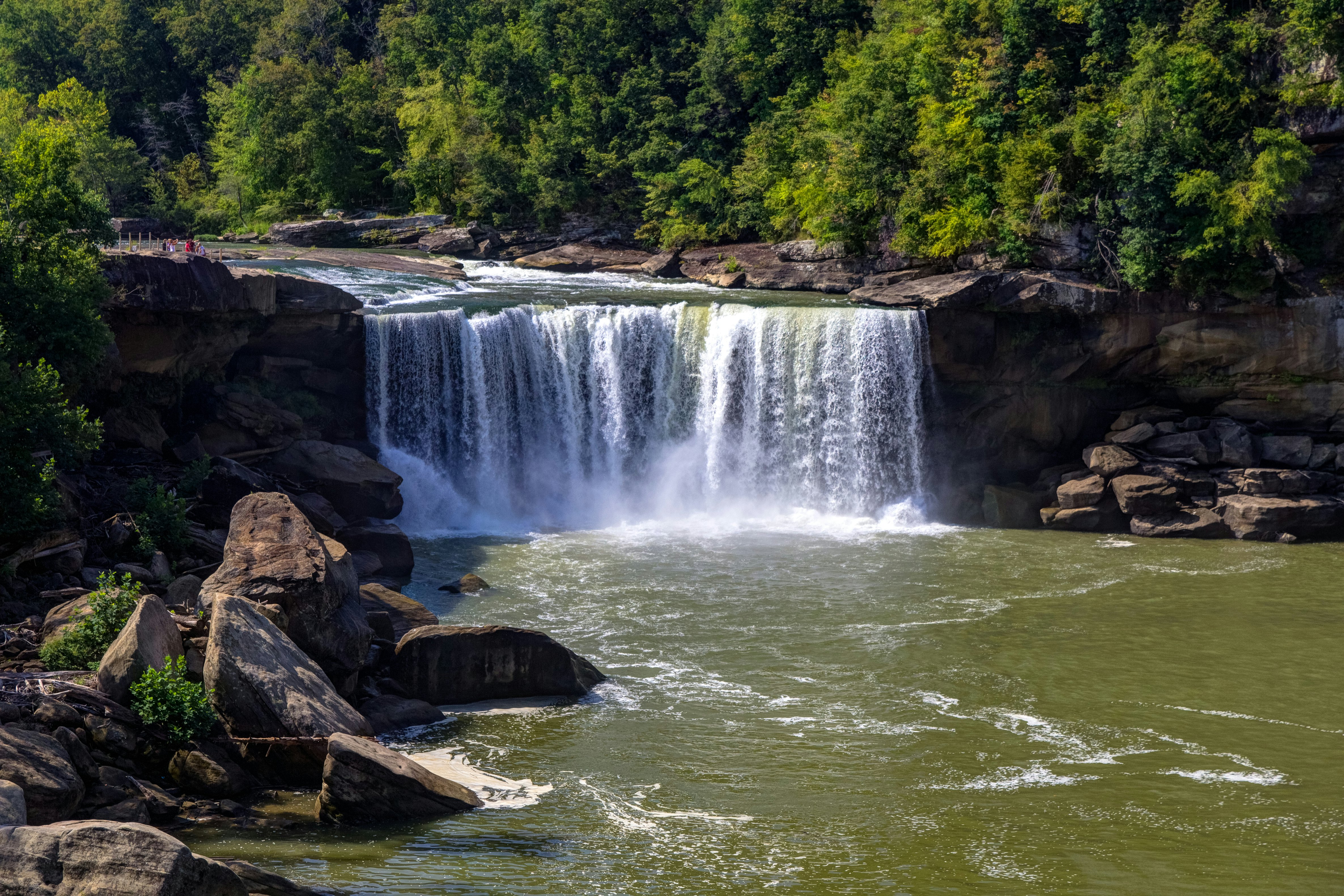
Kentucky: Kentucky Wild Rivers
Say the word Kentucky and most travelers will immediately think bourbon, bluegrass, and horses. While that’s perfectly understandable, don’t forget the wild waterways. With more than 2 million acres of national forest and more navigable rivers than any other state in the lower 48, paddlers can take their pick from more than 1000 miles of running water. Nine of them are designated Kentucky Wild Rivers, which means they are, and always will be, protected from development. Novice paddlers will find gentle waters on the Cumberland River, while experienced whitewater enthusiasts will enjoy the Class IV rapids found on the Big South Fork River; and, of course, there’s something for everyone in between.
Louisiana: Cajun Country
When it comes to an eye-opening, transformative trip, Louisiana’s Cajun Country may be unrivaled in the US. Here, about a four-hour drive northwest of New Orleans, a diversity of cultural traditions came together in early colonial days, with French, Spanish, African American, and Caribbean people mingling language, cuisine, and religious traditions in a way not found anywhere else in America.
In and around the town of Natchitoches (pronounced nack-a-tish), you can tour winding European-style streets, see authentic Creole cottages, partake of distinctive dishes like gumbo and jambalaya, and get to know the history of plantations like Melrose and Oakland, where enslaved Africans created finely crafted artwork that combined West African religious traditions with Christian iconography.

Maine: High Peaks Region
With Portland as your gateway city, exploring Maine’s extraordinary lakes and mountains is an unforgettable four-season opportunity that rivals the better-known “peak experiences” found out West. Located where the Appalachian Trail reaches its northernmost point, this region contains 10 of Maine’s highest peaks, with seemingly endless opportunities for camping, cycling, camping, and paddling glacial lakes and gin-clear rivers.
Wildlife enthusiasts will enjoy a moose photo safari, or just take a memorable drive along one of three scenic byways: High Peaks, Grafton Notch, and Rangeley Lakes. Autumn brings some of the deepest reds, golds, and oranges anywhere in the US, and winter offers cozy cabin fireplaces and some of America’s finest ski resorts.
Maryland: Chesapeake Bay
Maryland’s star attraction may be the Chesapeake Bay, the largest estuary in the US, which manages to touch beautiful waterfront towns, wild spaces, and the state’s biggest city. With such a variety of settings, the activities for visitors are nearly infinite.
For starters, be sure to experience Annapolis, the state capital and the sailing capital of America; a ferry ride to Smith Island, where residents still speak with a trade of the Elizabethan accent of the first settlers 350 years ago; Thomas Point Shoal Lighthouse, available for tours via a ferry from Annapolis; and Baltimore’s Inner Harbor, with its great seafood, public concerts, and National Aquarium.

Massachusetts: Falmouth
Some New England visitors know Falmouth only as a name on a roadside sign on the way to points farther out on Cape Cod. But this charming community on the western end of the Cape offers an array of affordable lodgings and activities to satisfy even the most discerning traveler.
Eight decidedly New England villages are set along more than 60 miles of shore here, with exceptional seafood, historic lodgings such as the Sea Crest on Silver Beach, and a great local theater scene that dates back to the summer stock of the early 20th century. Start at the Falmouth Village Green to get a sense of place; the bell you hear ringing each hour from the First Congregational Church was cast by Paul Revere – it doesn’t get any more New England than that!
Michigan: Charlevoix
Even seasoned travelers sometimes forget that the US has four coasts. The pristine beaches of Lake Charlevoix and Lake Michigan are found up north in Michigan, and offer a laid-back vacation experience that reminds many visitors of bygone days.
First, there’s the water and all that comes with it: charted sailboats, kayaks, and paddleboards; 20 hiking trails and nature preserves, not to mention the iconic Earl Young Mushroom House and the majestic Castle Farms. In search of seclusion? Head to Beaver Island. Looking for cool boutiques, great food, and public events along Round Lake? That’s exactly what you’ll find in the town of Charlevoix. No wonder visitors become regulars, and the Charlevoix region becomes a summer family tradition.

Minnesota: Lake Superior State Parks
Speaking of the beaches of the Great Lakes, northern Minnesota’s Lake Superior shoreline is home to eight state parks where nature lovers’ dreams come true. All reachable from the city of Duluth, some highlights include: Gooseberry Falls delivers not only Lake Superior shore but also Instagrammable waterfalls, rivers, and forest, a paved cycling trail, and excellent cross-country skiing; Split Rock Lighthouse, with a superb visitor center, exhibits, and documentary film; Temperance River offers gorges, footbridges, and waterfalls for hikers to discover; and Cascade River boasts trails that can get you up Lookout Mountain for – what else? – spectacular views.
Mississippi: Gulf Coast Islands
The Gulf Coast is always a good idea, and Mississippi’s Gulf Islands National Seashore is the perfect place to get up close and personal with the region’s wild side, amazing gourmet seafood, and craft beer.
The six barrier islands beckon visitors with attainable adventures like exploring the bayous and marshland of Cat Island; taking a boat ride from Biloxi to the beach at Deer Island; doing some serious pelican watching (and photography) on Horn Island; and hitting up the tiny islands of Round Island and Petit Bois for a look at visiting migratory birds (they’re here for the great seafood, just like you).
Missouri: Hermann
Just an hour west of St Louis, in the Missouri River valley, the town of Hermann is like stepping into a wormhole to old-world Germany. Start at Historic Hermann Museum for an overview of the settlement of the area from the 1830s to the 1900s. Then be sure to pack an appetite for comfort food and good local wine as you explore local eateries and favorite sights such as: Deutschheim State Historic Site with its exhibits and galleries of artifacts from the days when German immigrants settled here; Hermann Farm with its living history exhibitions; and a variety of excellent local wineries.

Montana: Bozeman
By Western standards, Bozeman is “near” both Glacier and Yellowstone National Parks, though folks from back East will notice that “near” can mean a few hours in the car. But we love Bozeman not just for its proximity to amazing parkland and amazing skiing but also for the city itself, a college town with great community spirit, food that even Californians envy, and one of the finest museums in the US, the Museum of the Rockies.
Set aside most of a day to take in all the museum has to offer, from its excellent planetarium to its Montana history division, natural history exhibitions with a special emphasis on the dinosaur fossils unearthed in Bozeman’s backyard at Hell Creek, and its living history pioneer cabin. In Bozeman, you’re never far from a gorgeous mountain vista or a great meal – we especially love the huge, reasonably priced sandwiches at the Pickle Barrel.
Nebraska: Grand Island
When it comes to friendly, historic towns, we love Grand Island. The community may be best known for its access to the epic Sandhill Crane migration here in central Nebraska, but that’s just where the fun begins.
Start in the town’s historic downtown, known as the Railside District, to take in the finely restored buildings, then grab a craft beer and grub at one of the excellent downtown breweries. Then explore the city’s Stuhr Museum with its Railroad Town pioneer village and beautifully landscaped grounds, and take a dip in one of Grand Island’s public pools. Be sure to visit the gentle Platte River, an important landmark from the days when settlers from the East headed west across the prairie.

Nevada: Valley of Fire State Park
How did Nevada’s Valley of Fire get its name? How about 40,000 acres of red sandstone? Here in Valley of Fire State Park you’ll come face-to-face with the ancient, including petrified trees and petroglyphs left by native people more than 2000 years ago.
Hit the park’s visitor center for an overview and great exhibits devoted to prehistoric times, geology, and the history of the region – pick up maps and tips here as well. As wild as the terrain looks, the park still provides two campsites with tables and grills and running water (including RV hookups), plus miles of trails for those who want to explore this unique environment.
New Hampshire: Seacoast
When you mention New Hampshire’s “coast” to some people, they look at you kind of funny. Sure, New Hampshire is mostly landlocked, and better known for its mountains and forests, but it also boasts a vibrant Atlantic shoreline that’s just a few miles long but includes the cool small city of Portsmouth with its cobblestone streets, winding alleys, historic John Paul Jones House and Strawbery Banke, and quaint shops like the excellent Riverrun bookstore, plus lovely beaches and more. Take kids to the Seacoast Science Center for a hands-on deep dive into marine life, including a “please touch” tide pool and other stuff the little ones love to explore.

New Jersey: Asbury Park
Asbury Park has been dubbed one of America’s Coolest Small Towns in 2017, featured on Bruce Springsteen’s debut studio album and regularly called one of the best destinations on the Jersey Shore. Yet few people have heard of it. It’s time to visit before everybody else gets the word. Conveniently located between New York City and Philadelphia, and boasting amazing seafood, art galleries, and legendary music venues and the boardwalk that Springsteen helped put on the map back in the 1970s, Asbury Park welcomes visitors from everywhere and delivers a first-rate weekend escape.
New Mexico: Carlsbad Caverns National Park
The jaw-droppingly beautiful Guadalupe Mountains in southeastern New Mexico, not far from the Texas border, are the site of a national park whose secret is about to get out: Carlsbad Caverns National Park offers beautiful terrain to hike, including canyons, cactus, grassland, and its namesake cave – which is a staggering 250ft high and 4000ft long.
Ranger-led tours of the caverns, plus hikes and other programs at the visitor center and out in the park’s terrain are a wonderful way of getting to know this noteworthy landmark.

New York: Blue Mountain Lake
When visiting New York’s six-million-acre Adirondack State Park, it’s easy to forget you’re even in New York – the mountains and lakes make you feel transported to, say, Wyoming. Of all the communities in this, America’s largest state park, Blue Mountain Lake is an ideal place to begin your exploration of the region, thanks to its incredible namesake lake and the Adirondack Experience, an immense museum with state-of-the-art interactive exhibits devoted to the natural history, human history, and wildlife of the Adirondack Mountains.
Set aside at least a full day for the museum, or visit more than once in between paddling local waterways, hiking to scenic overlooks, and enjoying great BBQ and craft beer just about everywhere you turn. Just up the road from Blue Mountain Lake, Great Camp Sagamore offers a rustic, unplugged experience you’ll never forget.
North Carolina: Boone & Blowing Rock
Take the Blue Ridge Parkway into North Carolina and you’ll notice that the area around the town of Boone seems to have received more than its fair share of stunning scenery. Endless hiking trails and scenic overlooks abound outside of town – you must experience the Mile High Swinging Bridge with its views of the Carolina Piedmont.
In town, there’s just as fine a variety of living history like the Hickory Ridge Museum and the Daniel Boone Heritage Gardens. In nearby Blowing Rock, you’ll love the Ultimate Adventure park’s ziplines, and the town’s nice array of quaint shops and indulgent spa treatments.
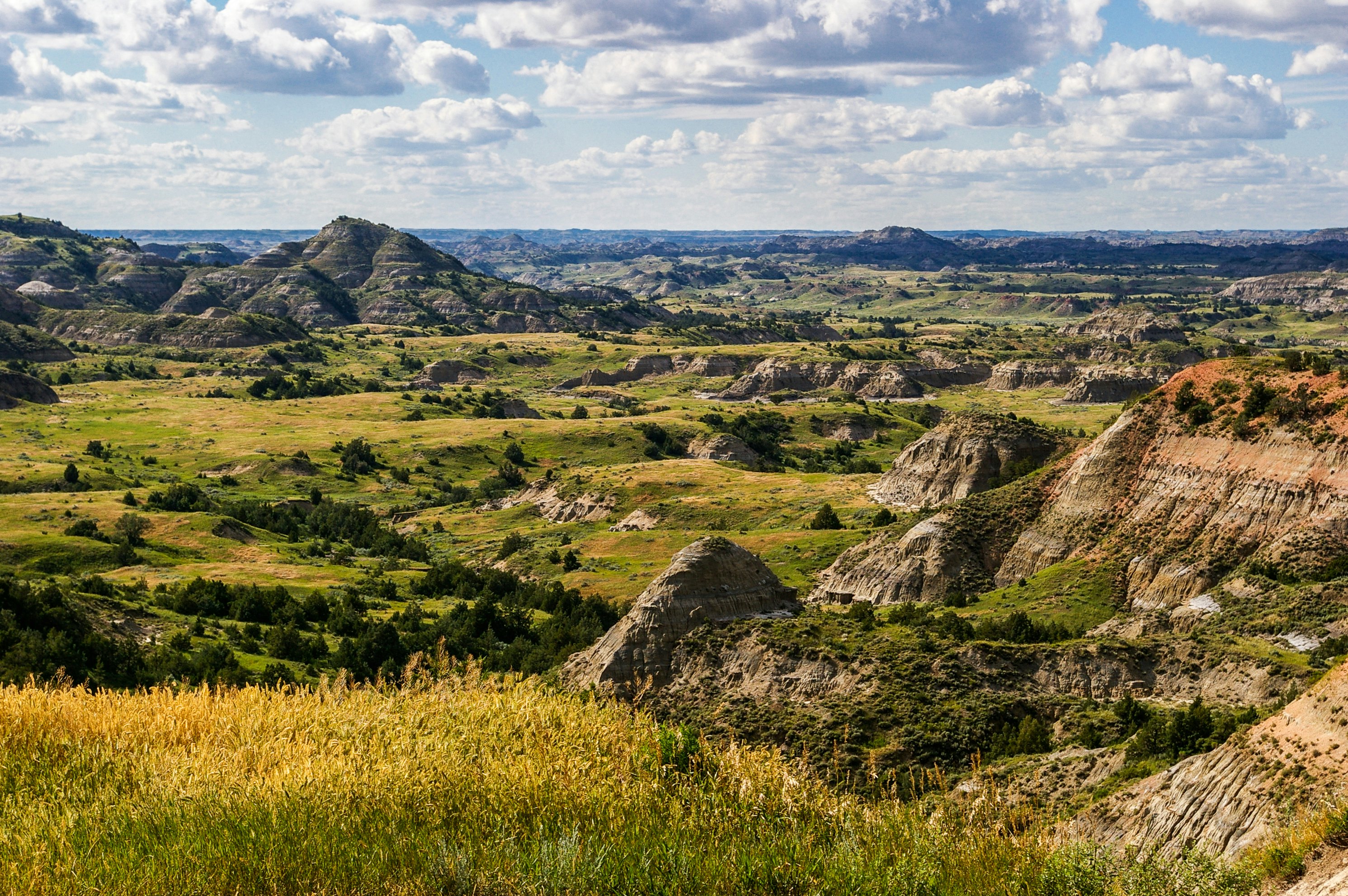
North Dakota: Dickinson
Cowboys + dinosaurs – what’s not to love about North Dakota’s star attractions? The town of Dickinson is best known as the gateway to amazing Theodore Roosevelt National Park, and it enjoys two scenic byways, the Old Red Old Ten and the Kildeer Mountain Four Bears.
But the town itself is decidedly ready for its close-up. The Dickinson Museum Center exhibits life-size dinosaurs, fossils, and other reminders of ND’s prehistoric residents; an assortment of beautiful spots like Patterson Lake Recreation Area and West River Community Center for watersports; and annual festivals like Roughrider Days and the Ukrainian Festival bring the community together and are a great time to pay a visit.
Ohio: Put-In Bay
Ohioans know there’s a 2.5-by-5-mile island in Lake Erie that makes for a spectacular vacation. And now you know too. Put-In Bay is one of those family escapes that pack plenty of great activities and attractions into a small package.
The island boasts a cave you can explore, winery tours, parasailing, jet skiing, and fishing for the area’s prized walleye. And don’t miss the chance to ride the elevator up to the observation deck atop of Perry’s International Peace Memorial for endless views of Lake Erie all the way to the Cleveland skyline when the air is clear.

Oklahoma: Tulsa
You don’t have to be a devotee of folk singer Woody Guthrie, composer of “This Land Is Your Land,” or of novelist S.E. Hinton, who wrote The Outsiders when she was 15 years old, to fall in love with Tulsa. But it won’t hurt. Those two pop culture iconoclasts, whose work happens to have deeply touched and even transformed lives, hailed from this Oklahoma city.
That may not be a coincidence: From its unique 100-acre Gathering Place public park along the Arkansas River to the Philbrook Museum’s collection of art from the classics to the modern era in a Renaissance-style villa built by the founder of Philips Oil and donated to the city in the 1930s, Tulsa exceeds expectations. You can even take a tour of a house that played a starring role in Francis Ford Coppola’s film adaptation of The Outsiders – the house has been meticulously restored and outfitted with artifacts and film memorabilia.
Oregon: Columbia River Gorge
Choosing a National Scenic Area for your next trip guarantees you’ll be surrounded by natural beauty. And the Columbia River Gorge is the largest designated scenic area in America, with vistas that rival any in the world. The Columbia River runs from its source in the Canadian Rockies down through Washington State and into Oregon, where it eventually meets the Pacific.
Along the way, it has cut a majestic gorge through the Cascade Mountains, delivering dozens of waterfalls, some of which can be ogled right from the Historic Columbia River Highway. The opportunities for outdoor recreation along the way are extraordinary, including cycling the Post Canyon mountain bike network or hiking up Dog Mountain. And, this being the Pacific Northwest, you can pretty much count on great craft beer, fresh locally raised fare, and an array of pinot noir, chardonnay, and other fine wines.
Pennsylvania: Alleghenies
It’s time to get to know the Alleghenies, Pennsylvania’s vast south-central region between Pittsburgh and Gettysburg. You can expect a warm welcome in small towns that boast covered bridges and elegant Victorian-era homes.
Elsewhere, explore miles of mountain trails on foot or on two fat tires, and dive into this important historical region with its rich Native American legacy, Revolutionary War landmarks, and reminders of the early days of the republic, when this was literally the American frontier. College sports fans will enjoy a stop in State College, home to Penn State and its loyal fans, not to mention tasty comfort food and craft beer.
Puerto Rico: Culebra
We’ll get this right out in the open: when your friend tells you she’s visiting Puerto Rico but refuses to give away exactly where she’s headed, she may be headed to the 10-square-mile island of Culebra, about 20 miles off PR’s Fajardo coast.
Fans of Culebra, which was a US naval base until 1975, have good reason to keep it top secret. Twenty percent of the island is a designated national wildlife refuge, protecting endangered sea turtles and other wild denizens. So far, the island has been untouched by giant hotels, casinos, golf courses, and fast-food restaurants. If that sounds like heaven, get ready to explore Culebra’s “diamond-dust” beaches (the star is Flamenco Beach, but you’ll find others that are more secluded), snorkeling sites, and hiking trails.

Rhode Island: Narragansett
Everybody knows that Rhode Island is the smallest state geographically. What everybody also needs to know is that the small size belies a wealth of vacation opportunities. Narragansett may be Exhibit A: the town is home to four popular beaches, minutes away from affordable hotels, B&Bs, and vacation rentals via the town’s fine public transportation system. You can also opt for camping at Fishermen’s Memorial State Park, which locals prize for its “seaside village” atmosphere.
Get ready to snap pics of the Point Judith Lighthouse at the entrance to Narragansett Bay, and set aside some time to explore the unique and vital exhibitions at the Pequot Museum, devoted to Native American history and culture and the natural history of the New England region from prehistoric times through the arrival of European settlers and beyond.
South Carolina: Greenville
If you haven’t already heard the great word-of-mouth generated by folks who have visited Greenville, take it from us: if your idea of vacation perfection is a charming Main Street packed with great art galleries, excellent local restaurants, and a cycling- and pedestrian-friendly infrastructure and outlook, this is a place you must see for yourself.
Start in lovely Falls Park, where the 345-foot-long Liberty Bridge crosses the Reedy River (you can grab a great cup of coffee at the bridge entrance). Cyclists will want to hit the curiously named Prisma Health Swamp Rabbit Trail (say it five times fast, or just call it “Swamp Rabbit,” as locals do), which runs more than 20 miles from Lake Conestee Nature Park to the nearby town of Travelers Rest. Tour local craft breweries, visit one of the local live theaters, hit up local galleries, studios, and public murals, and you’ll soon be one of the people spreading Greenville’s great word-of-mouth yourself.

South Dakota: Wind Cave National Park
What’s the oldest national park you’ve perhaps never heard of? Wind Cave, in the prairie grasslands in the southwestern corner of South Dakota, where the buffalo roam along with elk and other wildlife, was founded in 1903 and consists of lovely preserved prairie aboveground and an intricate cave system below, known for rare rock formations called boxwork.
Easy hikes and ranger-led programs abound, including a 1-mile round-trip hike from Elk Mountain campground, a loop from Prairie Vista visitor center, and, of course, tours of the cave. Note that as we publish this story, the elevators at Wind Cave are closed for maintenance – please check nps.gov/wica before planning your trip. Ranger programs, including an excellent documentary film, and above-ground activities remain open daily, and access to the cave will resume when maintenance is complete.
Tennessee: Franklin
Psst: seventeen miles south of Nashville, the welcoming small city of Franklin beckons with history (for starters, it was founded way back in 1799 and named for Founding Father Benjamin Franklin), great dining (there are more than 500 restaurants to choose from, and we especially love the upscale versions of Southern favorites like fried chicken and oyster po’boys), and unique shopping for locally made apparel, crafts, and snacks (if you haven’t the Tennessee favorite Goo-Goo Clusters, do yourself a favor).
Start on Main Street, designated a “Great American Main Street,” learn about the 1864 Battle of Franklin (and see the bullet-riddled Carter House), and spend some time on the Natchez Trace Parkway, which runs through Franklin and the village of Leiper’s Fork, where great art galleries rub elbows with fantastic BBQ – the Natchez Trace runs from Nashville all the way to Natchez, Mississippi, and is the eighth most-visited site in the National Park system.

Texas: El Paso
El Paso’s unique location, in the far western corner of Texas, bordering both Mexico and New Mexico, utterly defines the city’s culture. As national attention has focused on this border region, El Paso has been in the midst of a construction boom, including new hotels, the restoration of a streetcar lines, new craft breweries, and even a Minor League Baseball team, the Pacific Coast League’s Chihuahuas, part of the San Diego Padres franchise.
Reasons to get to know El Paso include the beautiful El Paso Museum of Art with its collection of 12th-through-21st-century works; Franklin Mountains State Park, the largest urban park in America within city limits, with elevations reaching more than 7,000 feet above sea level; and, of course, a unique culinary tradition that blends Mexican traditions like exquisite tacos with Texas’s love of good steak, plus upscale taverns serving innovative dishes and great cocktails.
Utah: Moab
Sure, you want to visit Utah’s amazing national parks, but, like many travelers, you’re not sure where to start? One word: Moab. The Utah town is in close proximity to both Canyonlands and Arches National Parks, providing you with a comfy home base from which to explore the incredible red rock landscape that makes some visitors feel as if they’ve landed on Mars.
Here in Moab, affordable lodging, great Southwestern and gourmet food, and the Colorado River make for a beautiful stay. When you’re not hiking in one of the two national parks, be sure to set aside time to discover Dead Horse Point State Park, along the Colorado River with its seven-mile rim trail and great vistas that include some of the terrain in Canyonlands.

Vermont: Northeast Kingdom
As the name may suggest, Vermont’s Northeast Kingdom region, including Caledonia, Esses, and Orleans counties, is a world unto itself. You won’t find cities up here, but you’ll find plenty of elbow room, pristine lakes, and forests just waiting for you to discover them.
An array of state parks serves as the best way to plan your Northeast Kingdom adventure, offering campsites, cabins, and cottages – and in some cases a lodge – from Memorial Day weekend through Labor Day. Groton State Forest will keep you busy with more than 26,000 acres of fly fishing, swimming, and hiking.
Virginia: Jamestown Settlement
If you’re looking for a living history experience that dates back to the early colonial days, Virginia is the place to be. Jamestown Settlement is where the first permanent English colony was settled. Here, visitors are introduced to the settlement’s origins as a business venture, the ways in which the English arrival affected the local Powhatan Native American way of life, and the arrival of the first enslaved Africans on Virginian soil.
You’ll want to spend most of a day exploring gallery exhibits, documentary films, and outdoor re-creations of a Powhatan village, a 17th-century fort, and even a replica of a sailing ship that brought the first English colonists to what they called the New World. While you’re in the Jamestown area, you can further immerse yourself in colonial history with a visit to nearby Colonial Williamsburg and the American Revolution Museum at Yorktown.

Washington: Olympic National Park
Yes, the American West is so packed with amazing national parks, we can forgive you if you’ve overlooked a true gem on the Washington State coast. Olympic National Park covers nearly 1 million acres that includes an exceptional variety of ecosystems, including mountains, old-growth rainforests (yes, it may be drizzling during your visit, but that’s all part of the experience), and more than 70 miles of coast.
Visit the Elwha Valley, just 11 miles from the town of Port Angeles (a good place to find charming, affordable lodging), which is home to the popular Elwha River and the surrounding mountains that make for a lovely introduction to the park’s offerings. Hurricane Ridge is easily reached and the views on a (rare) clear day are incredible. Hit the Olympic Hot Springs Road and Whiskey Bend Road for access to a number of great trails like the Boulder Creek and Humes Ranch loop.
West Virginia: Lewisburg
If you love truly cool small towns as much as we do, you must discover Lewisburg, on the Greenbrier River, with its fabulous arts, outstanding artisanal food scene (think way beyond traditional Southern fare here, with menu items like the Middle Eastern spiced lamb burger), and eminently shoppable downtown.
Don’t miss the unique Salt Cave and Spa and its indulgent treatments and unusual location within a cave system. The opulent Greenbrier Resort is worth-it splurge that delivers value, and the grounds and restaurant are worth a visit even if you’re not spending the night. Head out along the stunningly beautiful Greenbrier River Trail, a repurposed railroad route that’s part of the West Virginia state parks system, for a hike or cycling trip; you won’t run out of things to see – the trail is 70 miles long.

Wisconsin: Green Bay
Sure, the name Green Bay is synonymous with NFL football, but there’s a lot more to this beautiful region of Wisconsin than adorning one’s head with an immense cheese replica. The city if named for the big bay on which it stands, and you’ll find plenty of “green” in the city’s wild-ish places, like the Brown County Reforestation Camp and the Barkhausen Waterfowl Preserve.
Families will love the Children’s Museum of Green Bay with plenty of hands-on experiences, the National Railroad Museum, including train rides through October and a Polar Express at holiday time. For grownups, brewery tours take you behind the scenes for a taste of the fine crafting going on here. Oh, and if you absolutely must have a football-themed experience in Green Bay, the Packers Heritage Trail is a cool city walk that takes you to commemorative plaques dedicated to the creation of the Green Bay Packers franchise.
Wyoming: Rockies to Tetons
First of all, yes, we adore Yellowstone. But we want you to know that Wyoming offers a wealth of other outstanding outdoor adventures. One of our favorites is the Rockies-to-Tetons road trip that takes you from the Snowy Ridge, in southeast Wyoming, all the way to Grand Teton National Park. Your first step will be visiting the Snowy Ridge Range, which includes the 12,000-foot Medicine Bow Peak, via nearby Laramie. Then you’ll have to tear yourself away from all that gorgeousness on your way to Dubois, where affordable hotels and the Longhorn Ranch Resort are options (as is taking in a Friday-night rodeo in summer).
From Dubois, you’ll head toward the Grand Tetons, ideally with a stop for rafting the Snake River in Jackson, then enter the beautiful national park, where you can try your hand at shooting some of the iconic peaks and landscapes made famous by photographer Ansel Adams. (And from Grand Teton National Park, you can sneak a visit to adjoining Yellowstone with no additional entry fee.)
Produced by Lonely Planet for GEICO. All editorial views are those of Lonely Planet alone and reflect our policy of editorial independence and impartiality.







